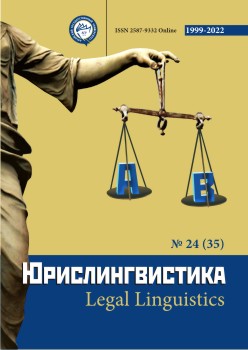Development of the Category "Women's Rights" in the Texts of International Legal Acts
Abstract
The given publication presents a study of enshrining and development of the category of "women's rights" in the current system of international legal acts. The authors emphasize the key role of the United Nations in ensuring and protecting women's rights. Therefore, the norm-setting function of the UN is of general importance for the implementation of the policy of gender equality and the protection of women's rights.
On the basis of a hermeneutic analysis of conventional acts, an attempt is made to show the positions of the international legislator regarding the content of the category "women's rights" and the closely related concept of "gender equality".
Having made an attempt at a terminological analysis of the definitions under study, the authors have shown that, doctrinally, the international legislator has not considered women's rights in isolation from those of men and provided for the arrangement of equal identical rights of both sexes. It has been found that in the 1950s specialized regulations for the development of the concept of "women's rights" were actively developed and adopted. Of particular importance is the Convention on the Political Rights of Women adopted by the UN General Assembly.
As a result, the article states that progress in defining the concept and content of "women's rights" proceeded evolutionarily. Conventions and pacts in this area were progressively adopted, women were given equal rights with men. On the way to achieving gender equality on the global scale, international acts ordered states to bind the principles of equal rights for men and women in their constitutions and current legislation.
Downloads
Metrics
References
Cohen D. Domestic Violence on the World Stage: Using International Standards as a Framework for Change in United States / Journal on Gender, Race and Justice. – 2014. – Vol. 4. 1. 1. Рp. 46-50.
Cusack S., Pusey L. Cedaw and the rights to non-discrimination and equality / Melbourne Journal of International Law. – 2013. – Vol. 14. – No. 1. – Pp. 56-60.
Агеева А.В. Международные правовые стандарты и проблемы защиты прав женщин / Современные научные исследования: теория, методология, практика. – 2013. – №3 (3). – Т.1. – С. 9-12.
Всеобщая декларация прав человека / Российская газета. – 1995. – 5 апр. – С.10-21.
Генеральная Ассамблея Организации Объединенных Наций. Специальные сессии. URL: http://www.un.org/ru/ga/sessions/special.shtml#22spec
Конвенция о гражданстве замужней женщины / Права человека. Сборник международных документов. М., 1986. С. 18-28.
Конвенция о ликвидации всех форм дискриминации в отношении женщин / Права человека. Сборник международных документов. М., 1986. С. 126-144.
Конвенция о политических правах женщин / Права человека. Сборник международных документов. М., 1986. С. 122-126.
Кротова Н.В. ООН и проблема международно-правовой защиты женщин / Гражданин и право. – 2007. – № 11. – С. 10-12.
Международный пакт о гражданских и политических правах / Права человека. Сборник международных документов. М., 1986. С. 45-73.
Международный пакт об экономических, социальных и культурных правах / Права человека. Сборник международных документов. М.,1986. С. 30-45.
Невежина М.В. Гендерная дискриминация в сфере труда: опыт борьбы на международном уровне / Журнал зарубежного законодательства и сравнительного правоведения. – 2018. – №3 (70). – С. 42-74.
Султонова А.Р. Гендерное равенство как фактор устойчивого развития мирового сообщества / European science. – 2019. – №4 (46). – С. 67-71.
Толстых В.Л. СOVID-19 и международное право: общие вопросы. / Московский журнал международного права. – 2021. – №3. – C. 45–62.
Устав Организации Объединенных наций от 26 июня 1945 г. / Международные акты о правах человека. Сборник документов / Сост. В.А. Карташкин, Е.А. Лукашина. М., 1999. С. 30-38.
Copyright (c) 2022 Александр Головинов, Юлия Головинова

This work is licensed under a Creative Commons Attribution 4.0 International License.
The authors, which are published in this journal, agree to the following conditions:
1. Authors retain the copyright to the work and transfer to the journal the right of the first publication along with the work, at the same time licensing it under the terms of the Creative Commons Attribution License, which allows others to distribute this work with the obligatory indication of the authorship of this work and a link to the original publication in this journal .
2. The authors retain the right to enter into separate, additional contractual agreements for the non-exclusive distribution of the version of the work published by this journal (for example, to place it in the university depository or to publish it in a book), with reference to the original publication in this journal.
3. Authors are allowed to post their work on the Internet (for example, in a university repository or on their personal website) before and during the review process of this journal, as this may lead to a productive discussion, as well as more links to this published work (See The Effect of Open Access).











